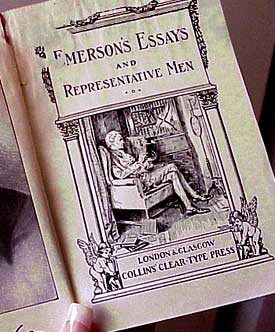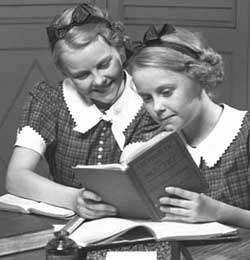The Print Media |
|
Books Part II
Puritans to Pirating Once America was colonized, printing press technology moved from Europe to "the new world." One of the earliest and most notable books was The Bay Psalm Book, printed 1640 by the Puritans. The Puritans were a religious group that settled in Cambridge, Massachusetts. They used their printed literature to promote and support their austere religious perspective. (Puritanical, a term derived from Puritans, now connotes people who are ultraconservative, super-religious, and prudish--which would seem to summarize this group's writings.) The next book of historic note is Poor Richard's Almanack, written and published by Benjamin Franklin. Franklin published books, newspapers, and pamphlets, some of which got him into trouble with people who weren't used to being criticized in print. You may recall that Franklin also achieved fame in early America as an inventor and an influential political figure.
By the mid-1800s there were many book publishers in America, and as a result the cost of books quickly dropped. This period also saw the beginning of many newspapers, some of which still exist today. Competition quickly drove the price of newspapers down to the point that some sold for one-cent each. (We'll discuss newspapers in an upcoming module.) Lower publishing costs also meant that books were no longer reserved for the rich. By this time public education had also become commonplace, which meant that a growing percentage of people could read. Soon, the reading of books began to catch on with the general population. By 1880, about one-third of all books published were paperbacks. These sold for between five and fifteen cents each. Most of the content of these paperbacks was pirated (illegally copied without compensation to the original author and publisher) from best-selling books being published in Europe. During this time, American book publishers shunned American authors (who they would have to pay) in favor of the free content (they could steal) from the European writers and publishers. Not unexpectedly, complaints ensued--complaints that in 1891 brought about the enactment of new copyright law. The law not only protected European writers and publishers, but forced U.S. book publishers to come up with their own original work. This helped launch the careers of many American authors. Authors such as James Fenimore Cooper, Henry Wadsworth Longfellow, and Ralph Waldo Emerson, became popular. (Apparently in those days authors didn't have short names like Tom Clancy, Steven King, and Danielle Steel.) Webster's Dictionary of the English Language, first published in 1836, provided a needed standard for English, and the Encyclopedia Americana became the standard source of information on just about everything. It was about this time that Uncle Tom's Cabin, which we mentioned in the last module, was published and established the power that a book could have over popular thinking. Many feel that this book was a catalyst for the Civil War. By the 1900s, book publishing had become highly commercialized. Publishing Books had caught on with the masses. But, some of the masses were not entirely happy with what they were reading. Books introduced new ideas and values into the cultural milieu. There were some people who felt that these ideas would debase society as well as their personal beliefs, and so they organized efforts to ban books they found objectionable. We'll discuss this in the next module. |
|
|
|
To next module To
index © 1996 - 2005, All Rights Reserved.
|


 Companies such as McGraw-Hill, Pocket Books, and Bantam Books arrived on the scene, and book clubs such as the Book-of-the-Month Club were founded.
Companies such as McGraw-Hill, Pocket Books, and Bantam Books arrived on the scene, and book clubs such as the Book-of-the-Month Club were founded.